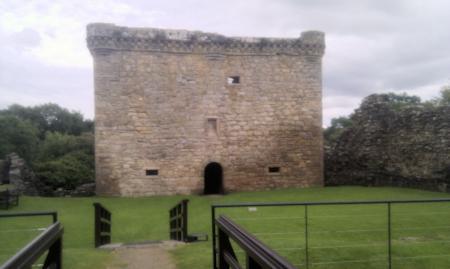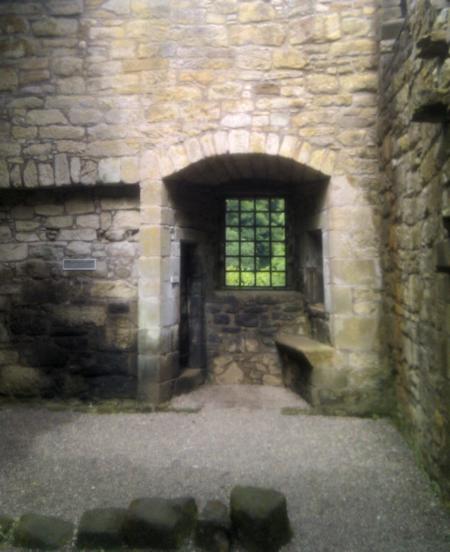
Craignethan Castle
Craignethan Castle was among the last truly defensive private castles built in Scotland. It is surrounded on three sides by steep cliffs leading down to the Craignethan Burn and the Water of Nethan. Its weakness lies on the western side where it is overlooked by the surrounding countryside.
Craignethan Castle was built in the 1530s by Sir James Hamilton of Finnart. He was given the barony and the lands by his father, James Hamilton, 1st Earl of Arran. Finnart was illegitimate however and he could neither inherit the Earldom, nor take his place as an heir to the Scottish throne. By the 1530s he was a rich and powerful man in his own right and he needed accommodation suitable for his noble status.
Craignethan Castle Layout
The main tower at the heart of the castle provided the main residence. Finnart had travelled extensively in Europe and he was an accomplished architect and military engineer. The castle reflects that in a number of unusual designs.
The great hall and Finnart's private chambers are at ground level. In most other castles they are placed on the first floor. Most tower houses also stack the rooms one on top of the other, but at Craignethan there is a cross-wall dividing the space in two – a common design feature in the 18th Century, but almost unheard of for a 16th Century structure. Lastly, the chimneys run through the middle of the building and provide efficient heating for the whole place whereas in most towers the chimneys are on the outer walls.
The north, south and east walls were guarded by steep ravines and the walls on these sides were normal medieval walls. The western side was the most vulnerable as it was the most obvious point of attack and potential attackers could shoot down into the castle.
The western defences were revolutionary for the time. Finnart had a tall, thick stone rampart built with a wide, deep ditch built in front of it. The western wall had gunloops just above its present height and its parapet had gaps to allow guns to fire up onto the higher ground to the west.
The modern day bridge is a little misleading. The western wall didn't have an entrance in it. Instead there would have been a bridge to the side of the rampart leading round to the gates on the side.
The most unusual feature was the caponier – a covered gun gallery located in the ditch. It was only discovered during excavations of the ditch in the 1960s. It was revolutionary in Scotland at the time and the fact that they fell out of favour in the late 16th Century means that this one is almost unique in Britain.
Slighting by Royal Command
Finnart fell out of royal favour in July 1540. He was accused and convicted of plotting against King James V. He was executed and Craignethan became the property of the crown.
Two years later James V died and James Hamilton, 2nd Earl of Arran took the castle back for himself. He was regent to the infant Mary Queen of Scots. He probably wasn't a frequent visitor as his main residence was at Kinneil House near Bo'ness, but it must have been useful for him to have Craignethan Castle as a secure hideaway in a time of political and religious unrest.
After Mary's forced abdication in 1567 he supported her. He helped her escape from Lochleven Castle and she stayed at Craignethan for a while. He was forced to give up Craignethan after the Battle of Langside in 1568. His brother Lord Claud retook the castle by force the following March.
In 1579 the Hamiltons were outlawed for their part in the assassination of James Stewart, 1st Earl of Moray. Craignethan was abandoned and then slighted by royal order. The north-west tower was destroyed along with the western rampart which was piled into the ditch, rendering the castle effectively defenceless.
The castle was regained by the Hamilton family, but was sold to Andrew Hay in 1659. He built a comfortable two-storey house in the corner of the courtyard. In 1730 the castle changed hands again, being sold to Archibald Douglas, Duke of Douglas.
The castle continued to decay in to ruin. It was Sir Walter Scott who brought it to public attention again. It is widely believed that Tillietudlem Castle in Scott's Old Mortality was based on Craignethan Castle. Scott is also believed to have considered taking up residence.
The 12th Earl of Home made some repairs to the castle around 1900 and the 14th Earl gifted Craignethan to the state in 1949. The castle today is run by Historic Scotland and is open to the public.
Visitors can tour round the entire castle and courtyard. Facilities available at the castle include a gift shop, picnic area and toilets. The castle also hosts various events and displays in the summer months.
Status: Ruin / Visitor Attraction
Owner: Historic Scotland
Tel: +44 (0)1555 860 364
Website: www.historic-scotland.gov.uk
Opening Times: April to September Daily 9.30am to 5.30pm


Craignethan Castle, Bridge and Tower

Great Hall at Craignethan Castle